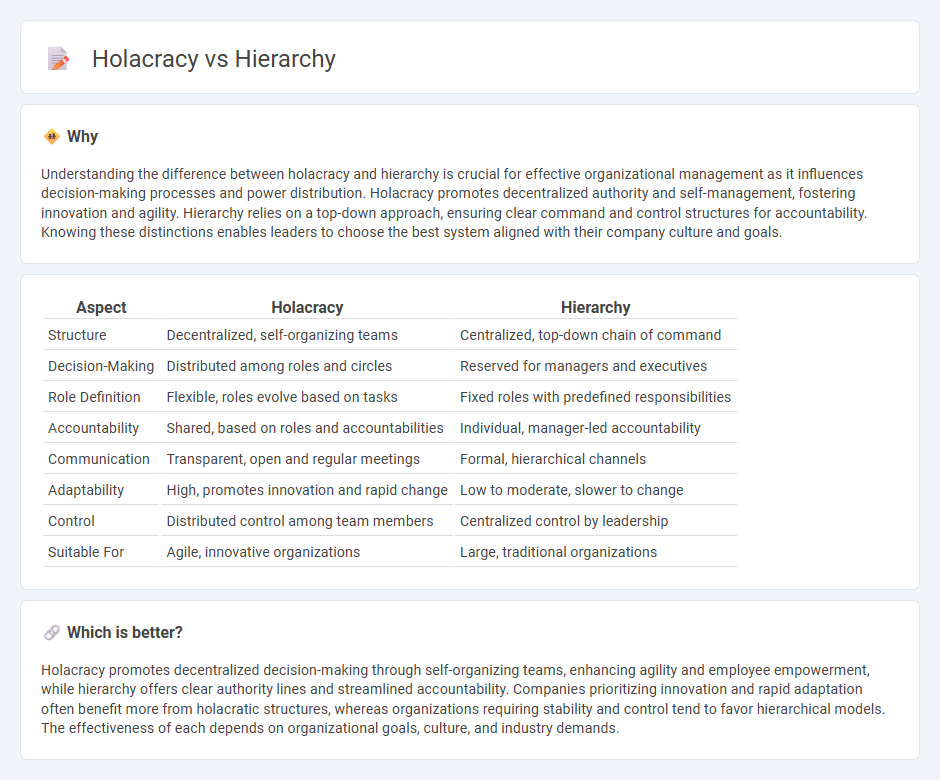
Holacracy replaces traditional hierarchical management by distributing authority and decision-making across self-organizing teams, enhancing agility and employee empowerment. Hierarchy maintains a clear chain of command with defined roles and centralized control, supporting stability and accountability in organizations. Explore key differences between holacracy and hierarchy to determine the best management structure for your business.
Why it is important
Understanding the difference between holacracy and hierarchy is crucial for effective organizational management as it influences decision-making processes and power distribution. Holacracy promotes decentralized authority and self-management, fostering innovation and agility. Hierarchy relies on a top-down approach, ensuring clear command and control structures for accountability. Knowing these distinctions enables leaders to choose the best system aligned with their company culture and goals.
Comparison Table
| Aspect | Holacracy | Hierarchy |
|---|---|---|
| Structure | Decentralized, self-organizing teams | Centralized, top-down chain of command |
| Decision-Making | Distributed among roles and circles | Reserved for managers and executives |
| Role Definition | Flexible, roles evolve based on tasks | Fixed roles with predefined responsibilities |
| Accountability | Shared, based on roles and accountabilities | Individual, manager-led accountability |
| Communication | Transparent, open and regular meetings | Formal, hierarchical channels |
| Adaptability | High, promotes innovation and rapid change | Low to moderate, slower to change |
| Control | Distributed control among team members | Centralized control by leadership |
| Suitable For | Agile, innovative organizations | Large, traditional organizations |
Which is better?
Holacracy promotes decentralized decision-making through self-organizing teams, enhancing agility and employee empowerment, while hierarchy offers clear authority lines and streamlined accountability. Companies prioritizing innovation and rapid adaptation often benefit more from holacratic structures, whereas organizations requiring stability and control tend to favor hierarchical models. The effectiveness of each depends on organizational goals, culture, and industry demands.
Connection
Holacracy and hierarchy both represent organizational structures but differ fundamentally in decision-making and authority distribution. Holacracy replaces traditional hierarchical chains of command with decentralized governance, empowering teams and individuals through defined roles and dynamic policies. Hierarchy relies on top-down control and fixed roles, whereas holacracy fosters agility and distributed leadership by emphasizing purpose-driven circles.
Key Terms
Authority
Hierarchy concentrates authority in a top-down structure where decision-making power is vested in specific roles or individuals at various organizational levels. Holacracy distributes authority across self-managing teams, enabling decentralized decision-making aligned with dynamic roles and purposes. Explore how shifting authority impacts organizational efficiency and culture in both models.
Decentralization
Hierarchy centralizes decision-making authority within a structured chain of command, often leading to slower responses and limited employee autonomy. Holacracy distributes authority across self-organizing teams, promoting decentralized control, faster adaptability, and enhanced employee engagement. Explore how decentralization transforms organizational efficiency and culture through these contrasting models.
Chain of Command
Hierarchy structures emphasize a clear chain of command where authority flows from top to bottom, ensuring defined roles and centralized decision-making. Holacracy replaces traditional chains of command with distributed authority across self-organizing teams, fostering flexibility and dynamic role assignment. Explore the differences between hierarchy and holacracy to understand their impact on organizational control and agility.
Source and External Links
Hierarchy - Wikipedia - A hierarchy is an arrangement of items, objects, or people into structured levels, where each entity is defined as "above," "below," or "at the same level as" others within a ranked system.
Hierarchy - Definition, Meaning & Synonyms - Vocabulary.com - Hierarchy describes a system that organizes or ranks things, often by power or importance, such as in organizations where positions are clearly ordered from top to bottom.
HIERARCHY Definition & Meaning - Dictionary.com - Hierarchy refers to any system of persons or things ranked one above another, commonly used to describe authority structures in business, government, or society.
 dowidth.com
dowidth.com